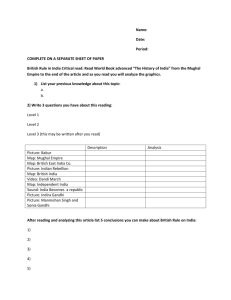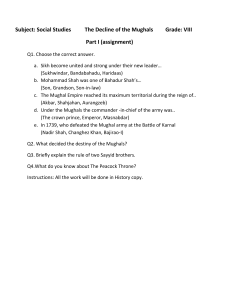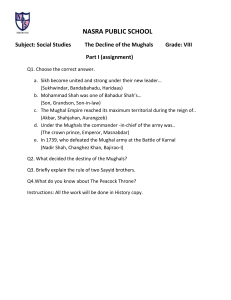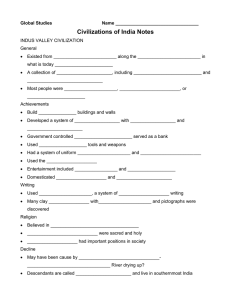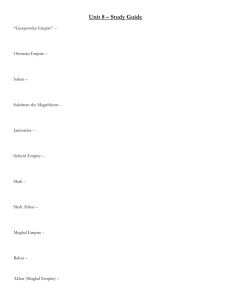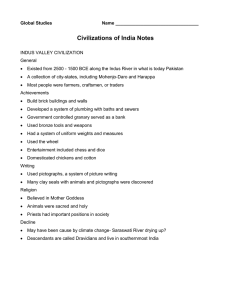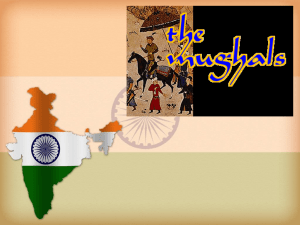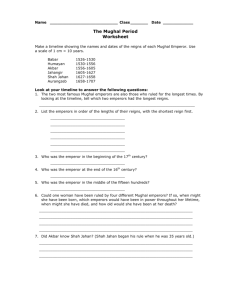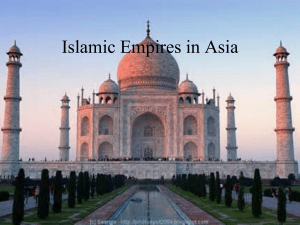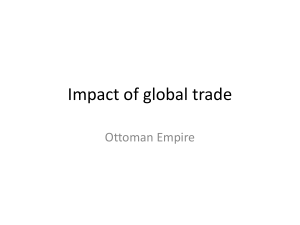Mughals
advertisement
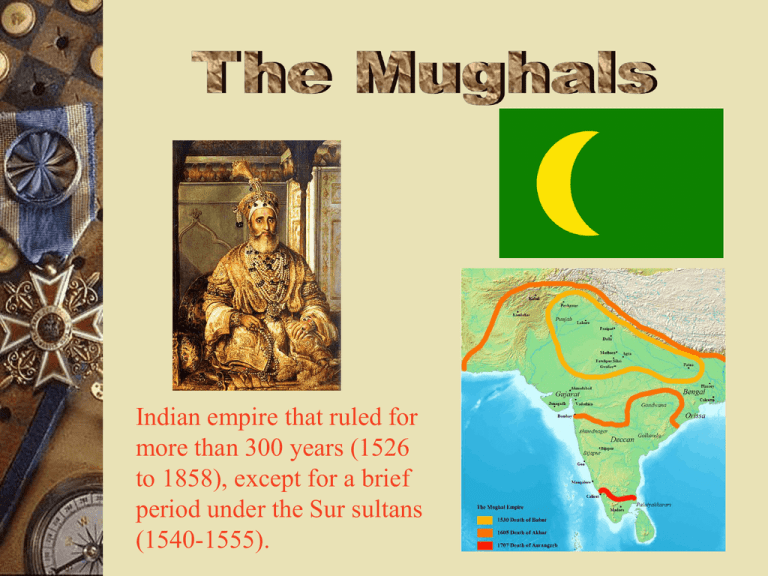
Indian empire that ruled for more than 300 years (1526 to 1858), except for a brief period under the Sur sultans (1540-1555). • Founded in 1526. • Dominated India between 17th and 18th centuries. • Empire ended in mid-1900s. • Descended from Mongolian ancestors around Pakistan. • Population at height: between 110 and 130 million people. • Sophisticated, mixed IndoPersian culture. Similarities: • Cuisine is very similar. Lots of meat. • Language is a mixture of multiple languages. • Art is similar (nature). Differences: • Very different geographic areas. • Very different traditions. • Clothing • Architecture is much different. • Time period. • Empire founded in 1526 by Emperor Babur. • Prospered under first 6 emperors, referred to as the Great Mughals. • 2nd emperor, Humayan, lost several battles to Sher Shah Suri, losing control of Hindustan. • 3rd emperor Akbar (circa 1700) regained control of Hindustan. Greatest Mughal ruler. • 5th ruler Shah Jahan built the Taj Mahal in 1653. • Empire declined under 6th emperor, Aurangzeb. Wars of succession, local revolts. • By 1765, the Mughal emperor had become a pensioner of the British East India Company. • Empire had several more mediocre rulers, finally ending in 1857 with expulsion to Burma (by British) of Emperor Bahadur Shah Zafar. • Centralized government system. • Persian art/culture merged with native Indian art/culture. • New trade routes with Arabs and Turks. • Mughlai cuisine. • New architectural style. • Landscape gardening. • Urdu language developed from the fusion of Indian and Islamic culture. • Urdu = Persian + Arabic + Turkish • Known for manuscripts and Persian miniature paintings. • Very symbolic. • Involved a lot of nature (birds, flowers, animals, etc.) • Very colorful and detailed. •In 1680 Emporer Shah Jahan banned music and painting from his court, but he allowed architectural art, such as the Pearl Mosque and the Taj Mahal. • Nearly 400 monuments have survived a time-span of 132 years. •White marble and red sandstone was favored. •Semi-precious gemstones were popular (jade, crystal, etc.) • Used arches sparingly. • Symmetry and balance stressed. • Used octagons a lot. • Kurta ~ an informal dress worn by Mughal men and women. • Sometimes sewn with gold or silver threads. • Cut in long, flowing panels for comfort; about knee-length. • Traditional wear in Afghanistan, Bangladesh, India, Pakistan, and Sri Lanka. • Spicy • Dried fruit • Rich and Creamy • Known for various sauces • Numerous kabobs • Not vegetarian! Ingredients: Flour Condensed milk Raisins Sugar sauce, (syrup) Butter, (ghee) • Hyderabad, Jammu, and Kashmir were the only princely states that did not accede to either India or Pakistan. • Currency is called the Rupee. • Language is a combination of Persian, Chagatai, and Urdu. •http://en.wikipedia.org/wiki/Kurta •http://www.amazon.com/dp/B001BWZJJ8/ref=asc_df_B001BWZJJ8735209/tag =dealt14869dealt&creative=380333&creativeASIN=B001BWZJJ8&linkCode=a sn (KURTA) •http://www.umdnj.edu/~humayun/mughals.html •http://en.wikipedia.org/wiki/Mughal_Empire •http://en.wikipedia.org/wiki/Mughal_era •http://www.wsu.edu:8080/~dee/MUGHAL/ORIGIN.HTM •http://encarta.msn.com/text_761564252___4/Mughal_Empire.html •http://www.exoticindiaart.com/paintings/Mughal/ (ART) •http://www.answers.com/topic/mughal-architecture •http://www.indianholiday.com/tourist-attractions/delhi/mughal-garden/ (MUGHAL GARDEN) • http://www.storyofpakistan.com/articletext.asp?artid=A020&Pg=5
